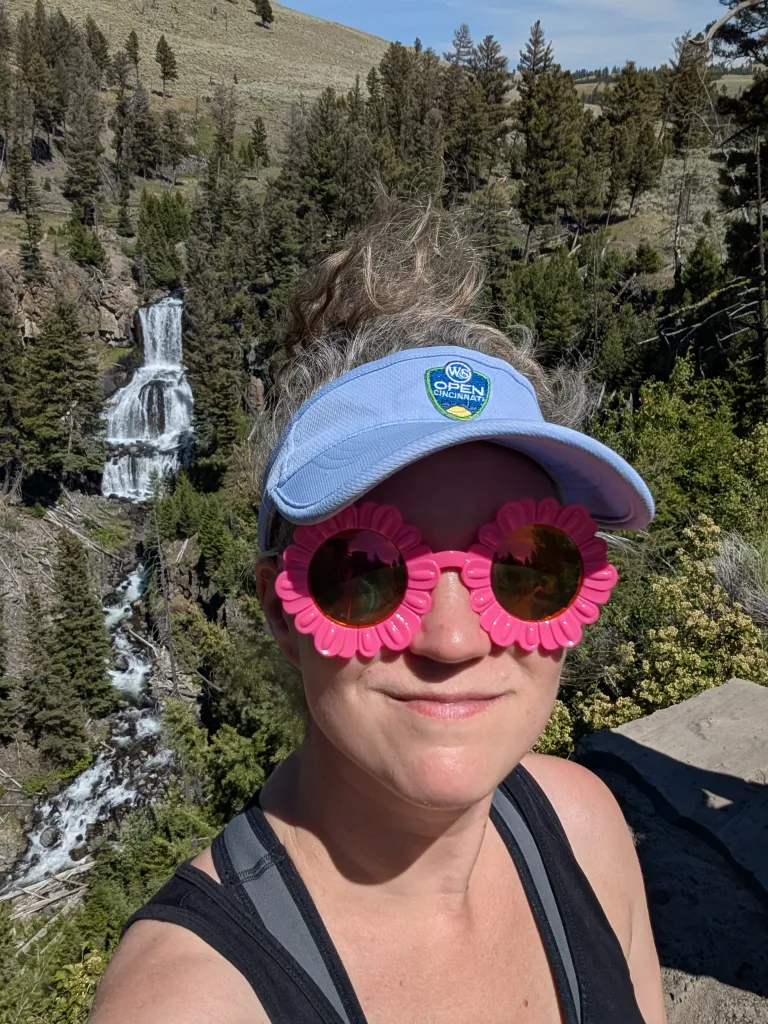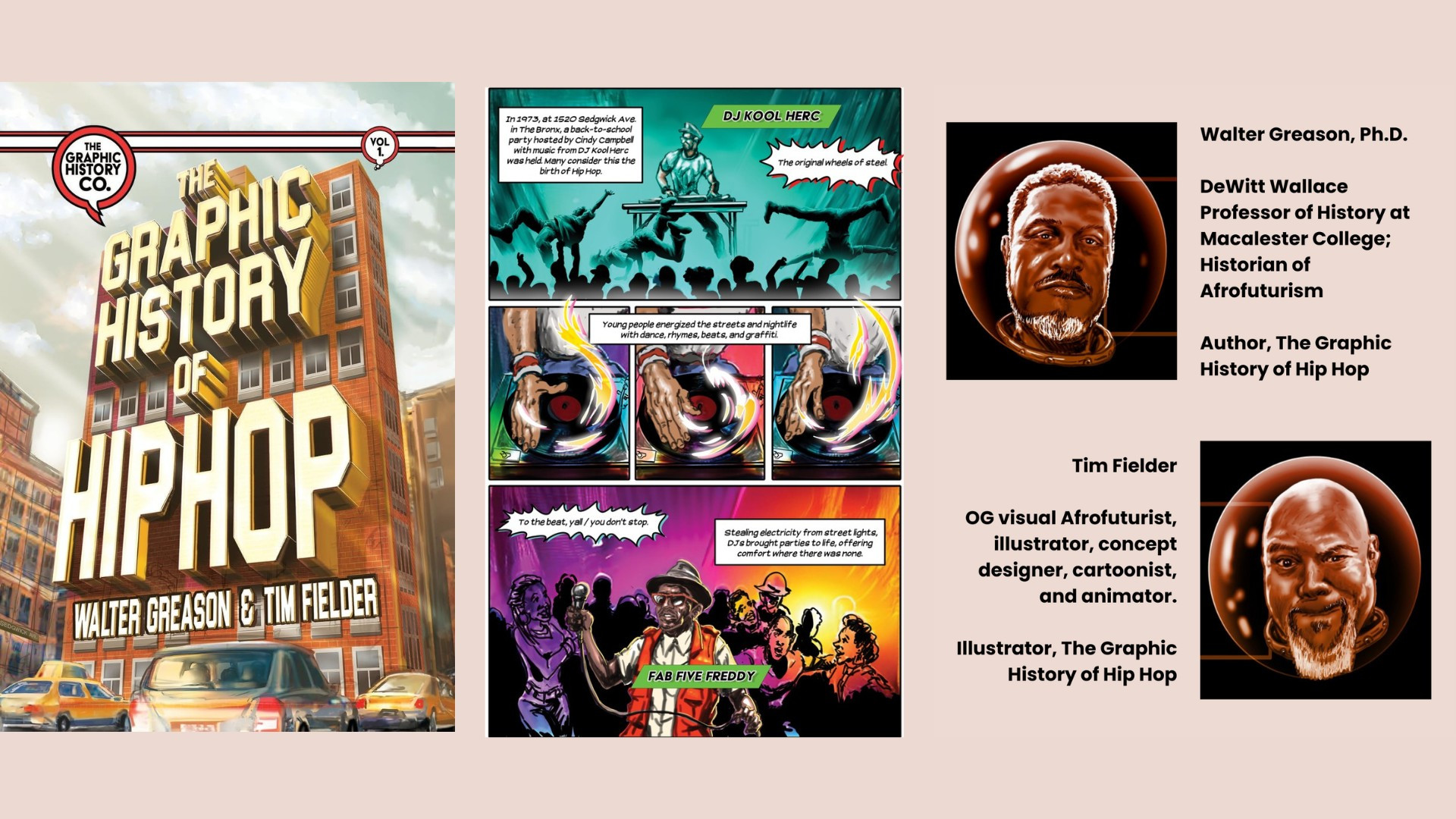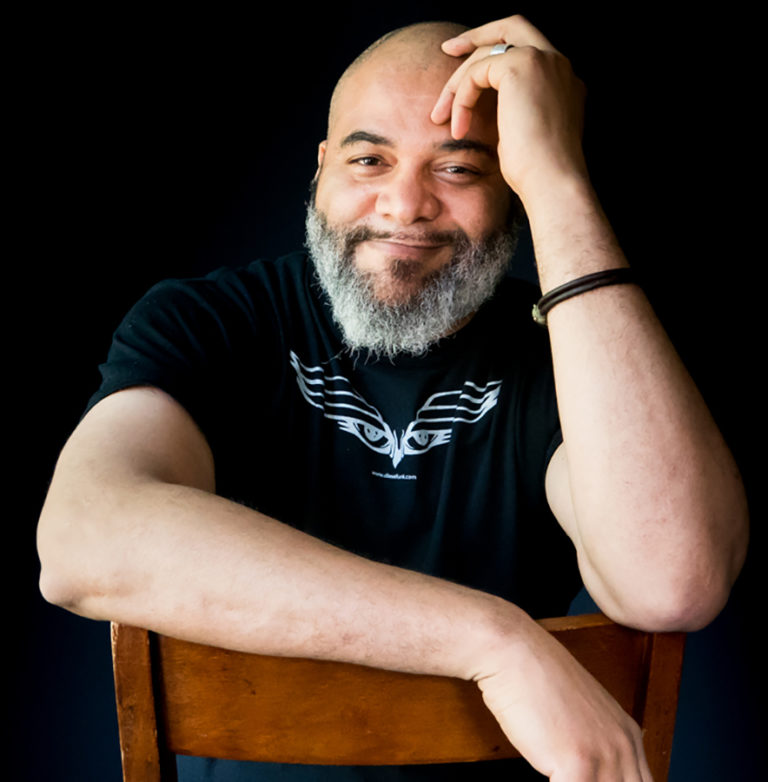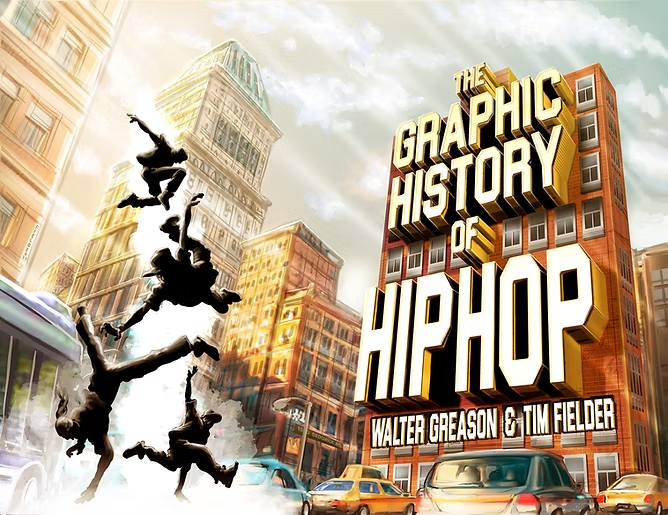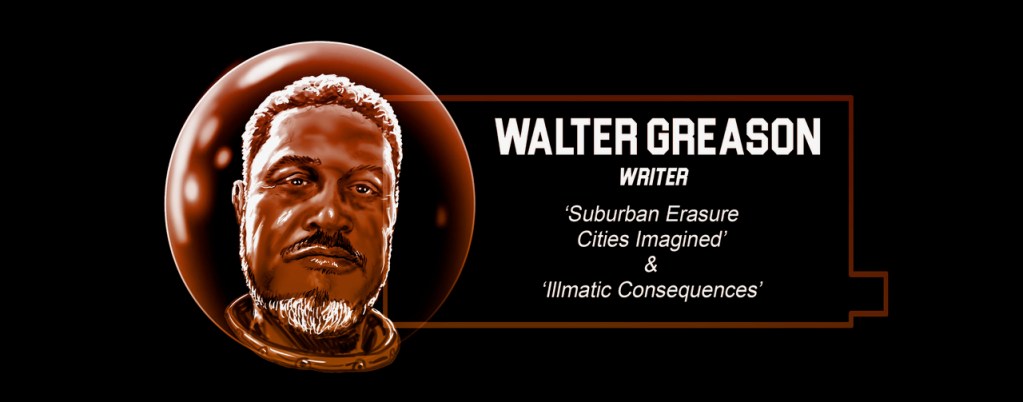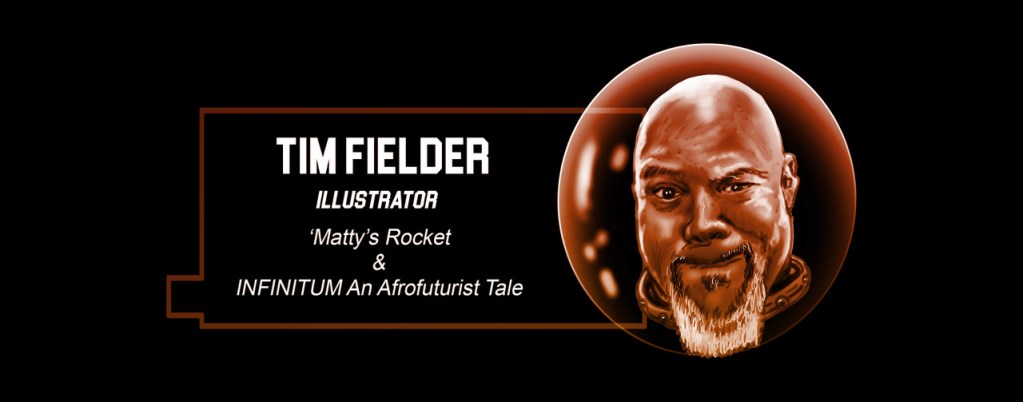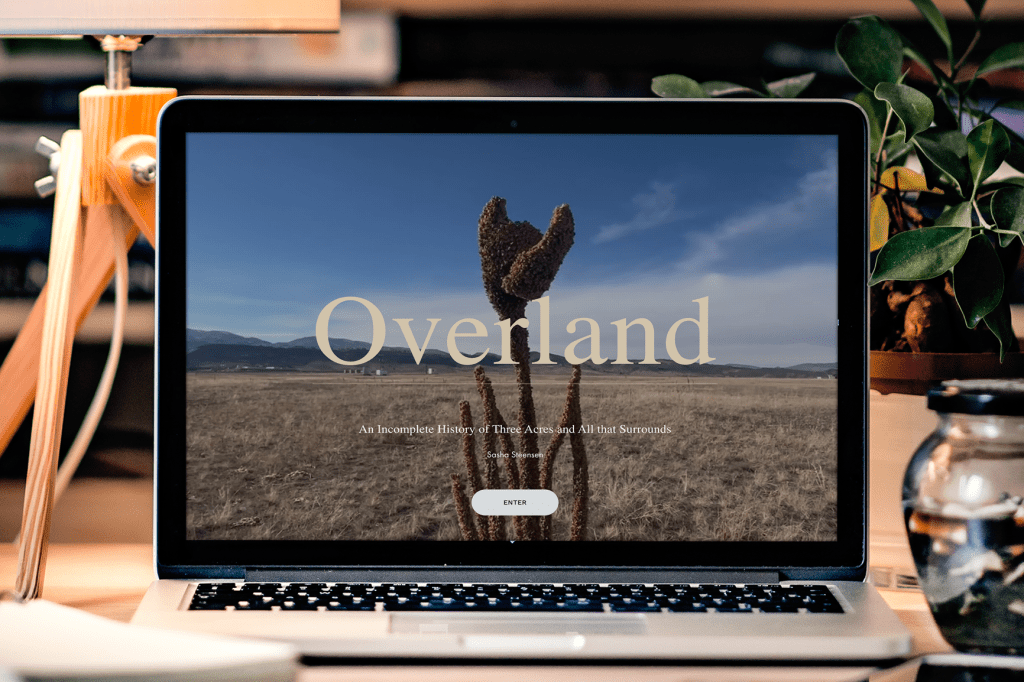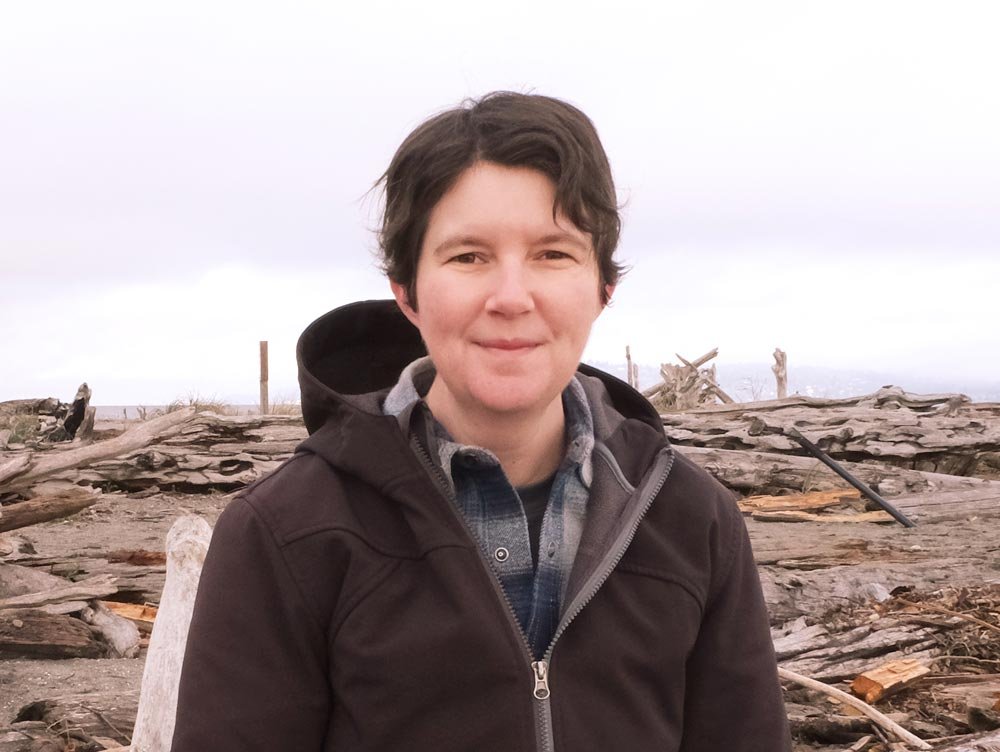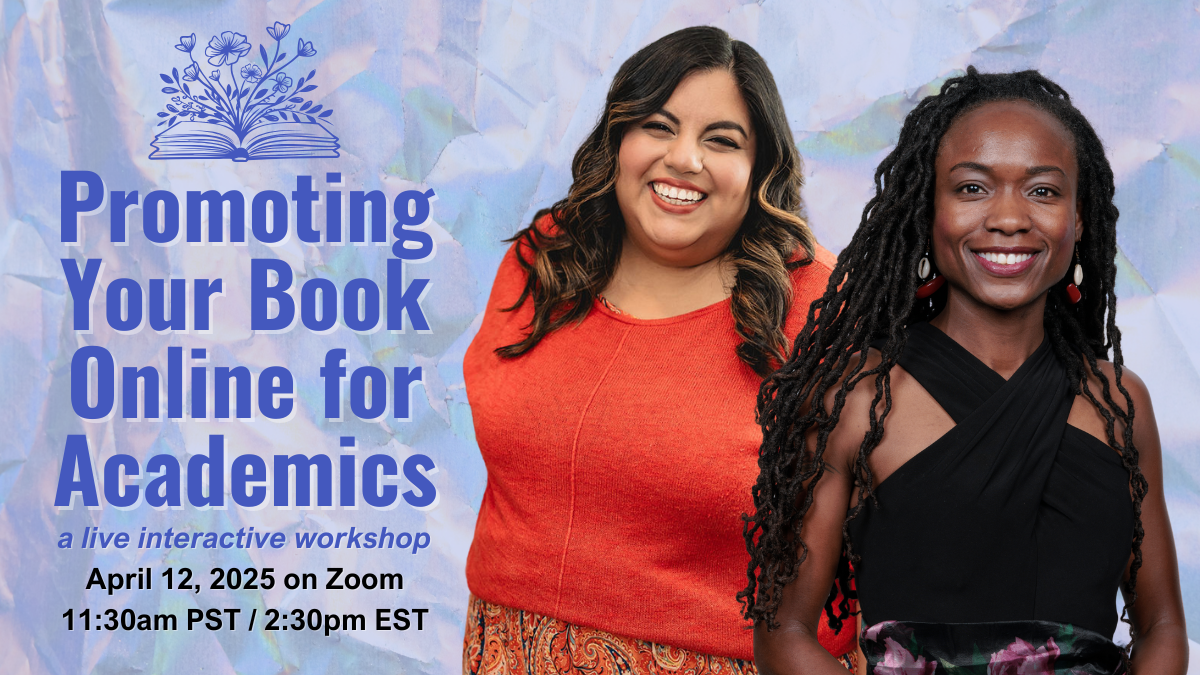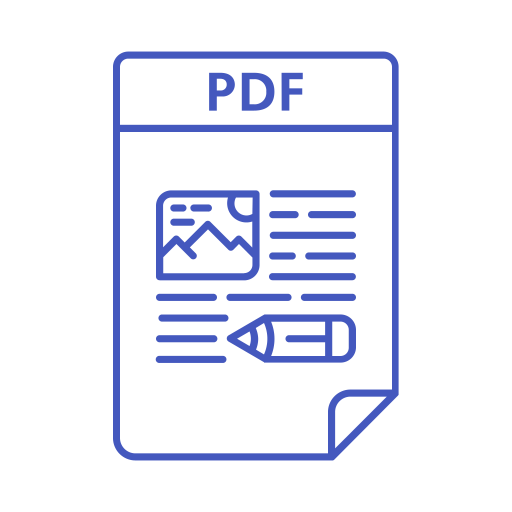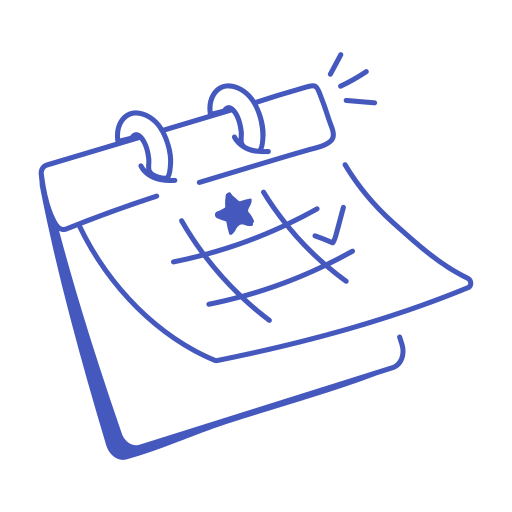What can academic writers do to have a digital presence that shares their writing and helps them connect with people online? Dr. Katy Peplin interviews The Social Academic podcast host, Jennifer van Alstyne in honor of Academic Writing Month (AcWriMo) in November.
Timestamps
0:00 Academic Writing Month (AcWriMo) with Dr. Katy Peplin and Jennifer van Alstyne
2:28 Your online presence is more than just social media
5:02 Cultivating authentic connections online for graduate students and faculty
10:18 Overcoming imposter syndrome and the lasting impact of sharing your story
14:56 Safety and community building online for academics and researchers
22:39 Jennifer van Alstyne’s tips for your personal academic website or research lab website
31:20 Did your university offer you a website? Yay. Keep this in mind
36:44 Aligning your online presence with your personal and professional goals
39:52 Your impact, your writing, your academic life matters
45:17 Build confidence by being intentional about how you show up online
49:09 Increase your impact with strategic approaches to your online presence
Academic Writing Month (AcWriMo)
Jennifer van Alstyne: Yay. I am so excited to talk about academic writing today because this is honestly a love of mine and I don’t do it anymore, but I help academic writers all the time with their online presence. I’m really focused on the digital side. Today I have Dr. Katy Peplin from Thrive PhD, and she’s going to ask me questions for academic writers because next month is academic writing month. Well, before we get to the questions, tell us a little bit about amo.
Katy Peplin, PhD: Okay, so I’m so excited here, but AcWriMo, which is so much more fun to write than it is to say, but is a National Novel Writing Month, which is a sort of longstanding decades old internet tradition at this point where people sign up and try and write 10,000 words of a novel draft in the month of November. There had long been sort of a community around novel writing in that way. Starting the origins of it now are sort of lost to the miss of internet time, but academics have been jumping onto it. I’ve been doing programming for this since 2018, which is quite a few years ago now. But I am really excited because the kind of way that we do it in the Thrive PhD universe, and now I have this great collaborator, Dr. Kate Henry, but we really believe in sort of building a writing practice.
Not necessarily belting yourself to your chair until you write that journal article or that chapter, but thinking about this as a month to intentionally touch in with your writing, touch in with your projects, experiment with things, and build some awareness around that writing practice. Let’s face it, November is the time where the end of the year looms closer and closer. All of these things that felt really far away in September or July when you’re like, “Sure, I’ll have that done by the end of the year,” suddenly become very real at the same time that semesters end and holiday stuff ramps up. Human things are so complicated. And, at least where I am in the northern hemisphere, the daylight goes away very suddenly. There’s just a lot of things that make writing in November even more challenging. I find that it’s been really fun and helpful to provide as much support as we possibly can for free that whole month.
Jennifer: I love it. This is one of the things that we’re creating to be a free resource for people. If you’re watching this and you are an academic writer, you’re friends with or supervise an academic writer, please share it with them. We’re going to be sharing tips, advice, and really the struggles that people sometimes go through when it comes to sharing their writing. So this video is for you. It really is.
Katy: Yes. I’m so excited to be asking you some questions because you’re such a leader and expert in this space.
I would love to just for the academics among us, how do you define an online presence? Because I know that’s one of those things that can feel bigger than it is, but also smaller than it is. What do you include under that umbrella?
Jennifer: I’m so glad you asked this question because I feel like people have a really limited view of what it is to the things that we create about ourselves. “If I don’t have a website, if I don’t have a social media, then I don’t have an online presence.” But that’s not true.
Your online presence is anything that people can find about you online, whether it’s intentionally created by you or not. So that’s Google Search results. Maybe if people ChatGPT get to learn a little bit more about you, what comes up? There’s a lot of ways that we can find what our online presence is, but there’s also a lot of ways that we can be intentional in creating and shaping how people find our story online.
Katy: That’s such a generous way to look at it because I know so many people who are like, I don’t want to be on LinkedIn or I don’t want to be on this platform. I don’t want to be here. I don’t want to be there. All of that makes sense to me. But it also can be what you want it to be. The kind of point is to be intentional about it.
Here’s 19 ideas for your digital presence as a faculty or researcher.
Jennifer: When we think it’s only social media, or only websites, or sometimes even only faculty profile, the thing that we’re often missing is your academic bio. Your bio is ending up on conference websites for journals, for events, programming, maybe fellowships or associations that you’re involved with. There’s so many places where your bio can show up online that it really ends up becoming a massive part of your online presence. People don’t expect that.
Katy: As somebody who has to regularly produce bios about myself and almost always feels some tension about it. Yes. That it’s such a good point that it’s more information about us circulates beyond where we put it on purpose. Right, exactly. Okay.
Cultivating authentic connections online for graduate students and faculty
Katy: What are the benefits that you see of for academics or people in the scholarly space that really do take that step to be intentional and thoughtful about the way that they show up online? What are the benefits that people can see from that?
Jennifer: I think the benefits that people maybe assume that they’re going to see is a lot of reach or maybe a ton of reads on their writing. And that kind of myth is, I mean, it’s not inaccurate. If you share more, people will find you more.
But the truth is that the benefits are really about the more individual connections, the reader who reads your writing and not only understands it and relates to it, but is citing it and helping share it with a larger goal in mind of being part of the research community. When I think about the connections that people are sometimes hoping for online, it doesn’t always equate to the meaningful deep relationships that they really enjoy that have come out of it. So whether that’s research, collaborations, new friends in your field, learning about a new conference or association that maybe you hadn’t heard of before, there’s so many opportunities for connection that we miss because maybe we just don’t think there’s agency in doing that, especially if networking feels uncomfortable to you.
Katy: Yeah, absolutely. I love the sort of way that you’re framing that because I think that for so many of us who reads us or even our H-index or these kind of really concrete data things are the easiest to measure. So we measure them first. But often they not separate from, but not necessarily as meaningful as we might want them to be in terms of the results we’re actually looking for.
Jennifer: To give you an example, so to be honest, I don’t share my academic writing much. I haven’t done academic writing since grad school. When I think about my own academic writing and my experience of sharing it, it’s been very surprising. I shared I’m in medievalist literature, and so when I shared an article that I had published, I was very surprised by the people who were responding to me: people who were not in my field, people who were not academics, people who cared about the literature, but I didn’t know that they did because they weren’t in the kind of environment that I was used to having these discussions in. Even my own experience, even though it’s relatively old now, I think that it was so meaningful for me to see the kind of invitation that my post ended up being that I didn’t expect.
I wasn’t like, “Oh my gosh, eight people are going to go read this article now that I’ve posted it on my personal Facebook.” But that’s what happened. Not only did that happen, but someone was like, “Oh, after I read this article, I brought it back to the grad school class where we’re talking about this book.” So then everyone ended up reading it, and I really thought that I was just posting to brag to be like, “Hey, I got this article out.” Like, you did it. This is great. As a grad student, I was very proud of myself and I wanted to share that feeling with people. While sharing your article can be the intention of your post, it’s also okay if you know what you’re sharing is more like me, like a feeling or the kind of warmth that we feel about our article and about our writing. It’s okay to be open about that even if you think that the people aren’t going to read it.
Katy: I love that so much, and I think that it’s such a brave and kind of generous thing to share because so much of the academic discourse is like I have officially done this important thing and I talk about it with important people and in important stoic ways. And sometimes you really are just like, listen folks, I passed my exams. There’s something so important about sharing authentically. I think that that’s something that academics can miss because in a lot of spaces we have that authenticity gently guided out of us or sometimes with a lot more force than that.
Jennifer: That’s true. Sometimes when my faculty clients we’re working together on social media. It’s pretty rare, but sometimes we’re actually focused on sharing their book or a specific publication or report that they’ve written. When that happens, they think that I’m going to tell them what to do. They think that I’m going to give them: here’s the specific template, we’re going to do all the things. Instead oftentimes we’re just having a conversation. I’m taking notes while we’re talking.
The things that you think already? The things that you want to share about your book already? Are good enough. They don’t need someone else to come in and tell you how to do it. Or what to do or what to say. It’s just that sometimes there’s things that we can add, or tweak, or enhance, because the thing that comes right out of our mouth, sometimes it needs a little bit of revision to help more people understand it.
Subscribe to The Social Academic blog.
The form above subscribes you to new posts published on The Social Academic blog.
Want emails from Jennifer on building your online presence? Subscribe to her email list.
Looking for the podcast? Subscribe on Spotify.
Prefer to watch videos? Subscribe on YouTube.
Overcoming imposter syndrome and the lasting impact of sharing your story
Jennifer: That’s a good question. I don’t think that I measure it, which is maybe the most interesting part of that. I’ll give an example. I had Meg Mindlin, who is an amazing graduate student, here on The Social Academic podcast. She has a very large platform on social media. She shares video. She shares octopus art. She is so cool. And, she has that same kind of feeling like, is this good enough to share? It doesn’t matter how large your platform is. You can still have that imposter syndrome. And frankly, it doesn’t matter where in your career you are. Meg is feeling that as a recent master’s student graduate.
And my clients who are mid-career and senior faculty? Many of them also still feel that way. I would encourage you to recognize that feeling. But maybe still practice it anyway because it might not go away. But you know what always makes it go away?
When my clients and I are doing this live on a call, we have a post, we’re ready to post it, we put it up and they get engagement sometimes while we’re still live. They’re like, “Oh, that’s a relief.” That’s a relief because I was scared about posting it. I did it. I was on the call with you, but now it’s out there and people are seeing it. The act of actually doing it, even if it’s just once or twice for this, even if you feel uncomfortable, it’s good practice. And I would say it’s okay to sit with that discomfort a little bit if you’re talking about something sensitive.
If you’re attracting negative reactions, I think that’s a different consideration. But for the vast majority of the things that you post, there are ways to talk about it that are not necessarily going to invite that kind of negative reaction. I just want people to feel a little bit more open to exploring it.
If you draft a post, hit publish, if it’s about your publication. Hit publish even if you’re not sure. So many of the people that I chat with are like, “Oh yeah, I drafted it, but it didn’t end up published.” Yeah, my hope for you is that it ends up published.
Katy: Oh, what a generous hope. It really reminds me of some of my favorite pieces of writing advice, which almost all boiled down to doing the thing is doing the thing. Writing isn’t necessarily thinking about writing, learning about writing, strategizing about your writing, drafting your writing, writing is writing. I think what you’re saying is sharing and building your presence is about sharing and building your presence. That there’s so much benefit in practice and doing it and learning that way as opposed to trying to perfect it up here first.
Jennifer: The results are long-term. Especially if we’re thinking about, I guess to be specific like a social media platform like LinkedIn, your post goes out today, maybe tomorrow, but that post has potential to reach people next week, next month, next year.
I literally went into my LinkedIn analytics yesterday and was like, wow, some of these posts are from over a year ago and they’re still reaching people this week. It’s surprising, but I think that potential was missed on old Twitter. You could reach a lot of people fast, but when the relevant people missed it the first time, they’re not going to see it later. That potential is possible on a profile like LinkedIn. It means that maybe it’s okay, you put a little bit of energy into your LinkedIn profile, even if you’re not job searching, you’re not doing any of the things like I get it, but LinkedIn can still help you reach all those people when you have something you want to say. It doesn’t have to be all the time.
Katy: As somebody who’s trying to uplevel on LinkedIn at this exact moment, I’m really resonating with what you say because it is this kind of vulnerable. They make it so easy to measure things like likes and metrics and shares, and you’re chasing that dopamine hit. You forget that the post lives beyond that initial kind of chemical brain reaction. It’s helpful to know good or bad that there’s a long tail.
Safety and community building online for academics and researchers
Katy: So I now have as from where you’re sitting, say I’m a graduate student, I’m an early faculty member, I’m even a late faculty member. Goodness knows, we’re all busy. I only have a certain amount of time.
What’s your best pitch for investing some of my precious energy into building this presence when it might not necessarily be something that’s directly measured by my advisor, my chair, my tenure committee, my colleagues? Why do it?
Jennifer: That’s a good question. I think that the advice that I had even a year ago probably would have been different, but I’ve had a lot of graduate students reach out this year because they want a stronger online presence. They don’t have the time, especially mid-career people with family or folks that are in a transition of fields. If you don’t have the time, but you still want an online presence, there’s ways to have that happen. You don’t have to work with me, but just know that there’s people that can help you and that you don’t have to do it yourself. Or, you can do it with a friend. There’s different ways to take back or make better use of some of that time if doing it yourself is not ideal. When you are planning to stay in academia, when you’re planning to have the research thinking projects that you’re working on now, be something that people can engage with long-term.
It’s always a good investment of your time to create your online presence. I would never suggest someone not create an online presence unless personal safety was really at not just the forefront of their minds but could affect their mental health. I’m saying that as someone who has been there before, I’m a survivor of domestic violence. When I left my physically abusive ex-husband, I deleted all my socials. I didn’t have anything. I didn’t want to be found online by anyone. So I’ve been there. But I also know the power of taking that space back and being really intentional about what people find there. Do I literally still worry that my ex-husband is going to email my clients and harass them? Yes, I’m not going to lie. Honestly, that is possible. And so when I think about how I show up online, I am very intentional about who is going to see this, how they can engage with it, and what the potential ramifications are if something goes wrong.
I think about that also right now in terms of protecting my clients when things in America are politically quite volatile for freedom of speech. There’s a lot of things that we can take into consideration in terms of time and energy that are beyond just us, that are a part of the larger world. But when it’s your own time, it doesn’t all have to happen at once. Any small change that you can make for your online presence.
Whether you’re in grad school or early career researcher, or much later on in your academic career, that time and energy makes a difference. Maybe you’re only updating a sentence or two in your bio. Maybe you’re spending a day focusing on creating that LinkedIn profile that you really did not feel like you needed in the past.
There are things that you can do and you have agency in doing, but it doesn’t all have to happen at once. And, it doesn’t have to happen at all if it’s not a goal for you. But for most writers that I talk to, it is a goal at least sharing their writing, sharing their research is a goal. I encourage you to have that online presence, even if it’s not the personal online presence that maybe you see friends or colleagues having too.
Katy: That is such generous advice. I’m so happy to hear you talk about the sort of risk of this because I know that I personally am working with a lot of clients who are afraid not just for their own sort of reputation online, but for the funding of their labs, for the ability to get doxed if they’re studying a thing that somebody finds. I think what you said earlier in kind of our conversation that you have an online presence, whether you work on it or not, that being able to shape things like how I appear on my department website, how I appear in my bios in places that people can access and could potentially freedom of information actor get access to.
All of that information exists online for most of us through these old conference programs, through all of these other things that more and more are being ingested or searchable in maybe ways that weren’t even two years ago. It’s going to happen whether you are intentionally engaging with it or not. This is maybe a moment for people to say, okay, how can I think about these presences and show up in them in a way that accurately represents my research. But also takes into account that “I need to stay safe, my colleagues need to stay safe, my students need to stay safe, and if they’re going to write it, I might as well write it.”
Jennifer: There’s power when we show up online. There is also an invitation for folks who maybe look like us, or think like us, or worry about the same things as us, or care about the same things. There is potential for those people to see the space that you’ve taken online and feel that they can claim some of that too, that they can also create more storytelling, more openness, more connection through what they’re able to share online.
Katy: I think about that with sort of my own presence all of the time because I am pretty open about my mental health struggles on my blog. I am incredibly privileged to do that in a lot of ways because I’m my own boss, so nobody’s going to fire me if I say something. If I can be the one to take on some of that risk and say, “Hey, I had a really crappy mental health day, and here are six ways that I reset,” and knowing that I’m putting that information out for people to encounter it when they need it to? If I can take that risk, then that lets other people take some of that burden off. That’s one of the ways that communities can function really generously is to say, okay, I have this space to take some of this on. Why don’t I host the meeting point for this idea so that you can benefit from it and maybe not have to take that on yourself.
Jennifer: Yeah, I really like that. And for graduate students who are teaching, early career researchers who teaching, is not just a focus for you, but something that you care about your online presence can really help your students. I have a whole article on The Social Academic blog. I feel like there’s so many people who maybe they’re not going to make an online presence for themselves. They’re not going to make an online presence for their writing, even if they want more people to read it. But they will make an online presence if they understand ways in which it helps more people, especially the people they’re teaching or helping mentor. I encourage you, even if you’re not thinking about this for yourself, it’s okay to think about it for other people too. Because sometimes you’re doing it for other people, and it ends up helping all of you. I think that’s really beautiful.
Katy: Yes, please do link that for me and for everybody. I think that’s one of the important ways to sort of think about this is that this nourishes all the way down. Just to give a practical example, I work with a lot of people who are looking for labs to join, looking for advisors, or they’re looking for even job searches and they’re trying to figure out fit. There’s so much information intentionally there and not sometimes that lets people know this is a good fit for me. I would be safe to research here. If you think about it like that, these are secret love letters to help you find the grad students who would be really aligned for you, the collaborations that would be really helpful. Then that can give an incentive where you should make a LinkedIn so that you can have a LinkedIn might not have that same hit.
Jennifer van Alstyne’s tips for your personal academic website or research lab website
Jennifer: Could I give an example of that?
Katy: Yes, please do.
Jennifer: I was working with a PI. We were working on the content for her website pages for the teaching section, and she was kind of wondering, “Should I make this more for the students? Should it be more for people who are evaluating me? I’m not sure who the audience of this page was.” I was like, first of all, let’s make it for the students because I think that’s what’s going to be most helpful. But second, if we can provide a little bit more information for them about your lab, about what it’s like to work with you, it will help them in their future careers.
She had this light bulb moment, which was, “Oh, last time I was looking through applications for people who wanted to join my lab. I noticed that one of the candidates had a specific lab that I had no idea what it was listed in their resume.” And she was like, “I couldn’t find information about it online other than a quick mention on a university website. So I had no idea how the research from this lab related to mine, and I almost passed the graduate student up.” When they met, they actually talked about the lab and had opportunity to see the connection more clearly, but that hesitation that almost stopped her from reaching out to the student to schedule that interview. When I think about the potential that is missed because PIs haven’t taken the chance to have a little bit of a stronger online presence, it can harm your students. I don’t want that to happen. If you have the capacity, if you have the space to think about how you’re showing up online. Or, if you’re a student in that lab that doesn’t have an online presence, can you add a description of it to your LinkedIn profile so people can learn more about it? You have agency, whether that’s inviting or letting your PI know that you would love for them to have a stronger online presence, or trying to find ways to create space for that yourself. You have options.
Katy: Yeah. That makes me sort of lead into this next question, which is writing for an online audience is such a specific skill. Are there ways that you can suggest that people can? Because I know that personally, if somebody said, “Hey, make a website to describe your lab,” I might be like, “I don’t know how to do that,” and sort of push it off because it’s so much harder. What are your top tips for helping people build that skill of writing for this specific context?
Jennifer: Before we can write for the specific contents, we kind of have to know what we want to write. The best resources that I have for folks who are like, “I want to create a website and I’m not sure what goes on it” is: I have one for personal academic websites and one for research lab websites. So there’s an answer for both of you, but it is a long list, a descriptive list of page ideas for your website. There’s so much content that you could add. And, there’s only a handful of that content that probably is most relevant to you. Before you start writing, think about what’s most important for me to share? I will link those articles below as well because they are great resources for anyone who is creating a website, updating a website. If you’re an academic who has that kind of permanent space online, check out these resources because that’s definitely the first place that I would recommend going.
A lot of people get stuck in the writing process. It’s a reason the services that I create really take most of that away, off of the plate of the faculty who I’m working with. So, I end up doing a lot of writing for folks. Sometimes that’s bio writing, which is its own project. Oftentimes, it’s condensing the things that we talk about in interviews and the materials that they’ve sent to me into written website content. But I want you to know that if you are like, “I can design my own website and I don’t really want to do my own writing,” there are still people who can help you with that. So reach out to me and I’ll help connect you with someone who may be able to support you in that process if you’re not wanting to do it yourself.
You can be a very strong academic writer. You can be a very good public speaker. You can be very good at all of these things and still feel like your web writing isn’t where you want it to be. This is not an insult to you. This is not a lack of knowledge or skills or capacity. Oftentimes, it’s much harder to write about ourselves than it is to write about other things. Especially things where, yes, you’re in research, you’re getting all of these inputs, data, places that you can cite and source and organize and reorganize. You are used to spending a lot of time on that. And when you think about spending that same amount of time on writing about yourself? It probably doesn’t feel the same way as you feel about your research. That’s okay. One: it’s okay to seek help.
Two: it’s okay to do it in steps. You could do a one page website first and grow it over time. Three: it’s okay to just publish it. If you’re not sure about your web writing and you maybe want to improve it, but you still want your website up, please, please publish it. Writing can always change over time and your website will 100% change over time. There is almost no one that I’ve ever met that is like, “I made this website once and haven’t touched it since then.” Oftentimes, it’s not going to happen every year, but every once in a while you’re going to notice, “This doesn’t quite feel like me anymore.” Those are things that you can address and change because it’s your space, because it’s your website.
Katy: There’s so much good advice and strategy in there. One of the things that I’m really hearing that is one of the common phrases out of my mouth too is that as academics, we are sort of taught that “writing is forever.” Once it gets published, it’s a thing and it exists and it’s citable. The reality is both about anything that’s kind of online and also in a lot of ways your academic writing, there’s snapshots of your thinking and time. If time changes and your thinking changes, then you get a new snapshot.
Did your university offer you a website? Yay. Keep this in mind
Katy: So many of us carry this kind of really resistance to being like, “I’m not sure that this accurately captures everything.” I can’t tell you: I changed my website five, six times a month because I’m always catching typos or things that didn’t flow or things I want to change or things I want to tweak.
Those things are so much more visible to me than they are to anybody else. I have built a thriving web presence with zero capital letters and many typos everywhere all of the time. That’s just sort of the brain that I have and the way that I show up. I move a little bit faster and break more stuff and have to kind of redo it. There’s something to be said for learning to do a skill and building it in public. A lot of us as academics are really used to learning in private building, in private researching in private and then presenting publicly and having it be really big stakes. I’m so much better of an academic writer because I started publicly writing those skills feed each other in a way that I didn’t expect.
Jennifer: Now, one thing that I want to mention about that is a free tool, especially for graduate students, early career researchers. Owlstown is a free academic website builder. If you are wanting a website and you’re like, “I don’t have website skills, I don’t really want to develop them,” Owlstown can set up your website in like 15-30 minutes. You can have a website today for free that’s easy to update and keep with you and kind of personalize a little bit even over time. I just want you to know that that is an option for you. If you’re wanting a website, you’re not wanting to do it yourself or work with an academic website designer like me, that’s okay. There’s options for you to still have that space online.
Katy: Also to have another sort of low cost plug, I know that my first academic website was hosted through my library at my university. Oftentimes there is somebody in the kind of beautiful war in of resources in libraries that if they don’t know where to do it for free on campus, they can absolutely help you with almost all of those parts.
Jennifer: This is definitely true, but I am hesitant to recommend it to folks. That’s because I have met so many people whose websites just disappeared when their universities decided to stop offering that service.
Katy: Oh, wow, okay.
Jennifer: Sometimes there’s notice, but sometimes there’s not. And so, I just want to be a friend. If you are creating a space on a site that is internal, that’s hosted by your university, yay, I’m so excited for you. Save a copy of all of your text. Save a copy of all your photos just in case. Just in case something goes wrong, I want you to have that so it’s movable to another space if you ever need it.
Katy: Yes. Speaking from people who lose access to their emails all the time, there is real wisdom in being use the university if they’ve got it. But keep a copy for you.
Jennifer: Oh, I feel like when I was in grad student, so much of the advice that was given to me was always use your university email address. This is how people are going to know that you’re legit. But the truth is, I lost access to all of those emails. I have no idea of any of the conversations that were shared, and I did not save them in time in order to keep them. When I think about that loss, that loss of what feels like archive to me, it makes me sad. So when I think about the writing that you do, yes, academic writing is important, public writing is important, anything that you create is important, but so are the emails and conversations that you have if they’re meaningful for you to keep. Yeah, this is kind of all areas of your life. If it’s meaningful for you, try and find a way of saving it.
Katy: Wow. That’s such good writing and information. This is what I find with so many of my conversations with really brilliant people in the academic spaces that we all find the places where everything all connects. One of them is that it just is really important to keep hold of what’s yours, whether that is your data, your information, and if there are ways to keep it personally, then it almost always behooves you to do it because as much as we would like to trust that the Higher Ed institutions are eternal and that our web space and storage will always be there. Goodness knows that things really can shift.
Jennifer: They really can shift. I was actually just hosting for ContentEd Live. It was a 48-hour Higher Education conference. What I found was that there’s so many people who are making very large decisions about things like website, things like technology infrastructure. They’re coming from a top down approach of making decisions that help and improve things for the entire community. Oftentimes they’re making decisions that affect faculty without recognizing some of the loss that can happen when this kind of decision happens. One example (this is not from the conference), but last year I had a client who came to me because his faculty profile. All of a sudden they’d removed all the email addresses from faculty profiles. So the place that was the home for his online presence no longer helped connect media, journalists, or research collaborators with how to actually get in touch with him.
All of a sudden there was this new need for an online presence that allowed for those things. Sometimes when those decisions come down from the top, they really do help everyone. This university got 30+ million SPAM and phishing emails each month. I understand why decisions are sometimes made. But when we don’t have control over them, it means that we need to be aware of what our options are for taking up space outside of those structures. We’re all working towards helping students, helping research, helping facilitate the meaning of Higher Education in the world and how it impacts the real lives of the people who are in it. But if we’re losing access to the things that matter most to us, then sometimes we have to recreate those spaces ourselves.
Katy: Absolutely. There’s something so important as we think about this whole umbrella of an online presence is thinking through what are the most important things for you in this presence? If one of them is “I want outside collaborators to find me, I want to be available for media, I want to be public facing,” then probably where you’re going to spend your time and energy is completely different than “I’m a PI. I want a steady stream of people in my lab who are values aligned and project aligned. They might spend their two or three hours a month completely differently than somebody who has these other kind of options.
Aligning your online presence with your personal and professional goals
Katy: One of the things that I’m sure that you see as well as I do is that people kind of get the advice. You have to have a website, you have to have this, you have to have that. And they don’t really think through, okay, what do I want this project? Because it is a project to do for me. And the more clarity you can have about that, the easier it is to make that project fit the need as opposed to trying to collage seven or eight things because somebody told you they were important.
Jennifer: 100%. Oftentimes I found that actually it may be seven or eight things that are important to you, but there’s a hierarchy for what those things are in terms of your energy, your capacity, what actually fits into your life. Sometimes we’re designing a website that is going to be attractive for media, for podcast invitations, even if that’s not something you’re actively reaching out to. But, the vast majority of our energy is going into explaining the lab and inviting people to explore the projects that you’re doing. I want to encourage people to create intentional time for yourself to think about the people you want to come to your website or to come to visit your online presence. Maybe it’s a LinkedIn profile. Who do you want to come there? How do you hope that they can engage with you? I had one person be like, I just want a repository.
I don’t actually want to engage with people, but I want them to find my writing.” That’s okay too. We just published her website. It is out there and it’s going to be with her for, frankly, a lifetime. Websites can be there with you for your lifetime. They can grow and adapt with you as your goals and needs change. Maybe media, podcasting, is not a goal for you now. But when you’re running a lab in three years, actually it would be great to have your research on a research podcast in your field. How cool would that be to reach only people who are really into the thing that you’re talking about?
Katy: Exciting. That’s pretty cool too. Yeah, I think it just is. So with so many things, the intentionality is key. And a little bit of effort in the front to be like, what am I doing with this? And, why do I want it? Can just pay dividends.
Jennifer: If you don’t want to work through that on your own, reach out. I’m happy to help you with that process. Or, to design your website for you. Whatever feels supportive.
Your impact, your writing, your academic life matters
Katy: Awesome. Are there any other things? I guess my last final question is if you were to kind of sum up the very best thing about working with academics specifically on their online presences (as opposed to micro influencers or content house kids or, I taught digital media, so I’m always like, Ooh, the handlers of famous internet cats). What’s sort of so special about this group that keeps you coming back to this incredibly specific but pretty diverse niche?
Jennifer: I’m really glad you asked about this. This is a question I’ve been thinking of a lot this year. This is the first year in my business where people from outside Higher Education are really like, what are you doing in there? What are you doing? It seems like your industry is imploding. You should consider coming and working over here, go work over there. I’ve had referrals for very large projects that are outside of academia and I don’t want any of them. The people who refer them, they love that about me to be honest, but they keep trying. And when I think about that, it’s really because the researchers, academics, graduate students that I work with, they are each creating meaning in the world. They’re each creating really interesting thinking, writing, teaching. The things that they do are also really varied. So my brain that really likes to be creative in different ways gets to work with people in a lot of different fields.
I get to learn so much from the people that I work with. I get to hear their stories and experiences and I relate to them. Even though I’m not in academia, I only work with academics. I mostly work with individuals. I’m not part of the academic world entirely, but I am supportive of this world entirely. Actually, at the conference yesterday, someone said, “We’re all across universities all around the world. We’re all working towards this hope.” And I thought, oh my goodness. I’m not a Chief Marketing Officer at a university, but I am someone who’s working on the same problem, who’s working towards this same future where research, and education, and teaching, and mentoring, and the service work, and all the things that faculty do for their society, it’s meaningful. And it makes a difference. And it doesn’t have to stay hidden.
I help people make connections that make more meaning and matter in the world for the things that they care about. And yes, I could go do that for a big company. I could go do that for, I don’t know, celebrities if I wanted to. I remember the first time that I actually, I pitched a musician on bio writing and he said yes. And I was like, “Oh wait. I dunno.” I didn’t end up doing that project, but I remember feeling like I can do a lot more. And also I don’t want to explore that, because I love who I work with. I’ve had to build some things into that flexibility to reschedule things. And that does change how I work with people. But it also means that I get to work with exactly who I care about supporting and I love it.
Katy: I got choked up when you talked about the hope because I think that I know. I was on parental leave for about 18 months and I kind of came back to a completely different online landscape. But also a pretty different higher education landscape too. I work with people and I think that appeals to a lot of people who are like, listen, I wouldn’t do this work if I didn’t believe so strongly that someone needed it somewhere.
There’s something so important to me about being a tiny bit of the support that holds up the people who are doing that work. There’s so much. I think about it a lot. I am not the rock that goes in the pond that has the ripples that we can’t even track, but if I can help hold that hand up just long enough so that they can drop it, they did all of the work. But if I could be on the side of the pond cheering and be like, it’s okay to drop it, I love it. I think that that really goes because there’s such a misperception about what academics are or what we’re doing or what we spend our time on. The majority of people are deeply invested in their research because they believe it has the power to change something for someone oftentimes for the better. The more that we can do this important work of being like, this is what happens in this lab, this is why it’s important that we put shrimp on treadmills, and this is why it’s important that I go through these archives and I look at all of these things. The more visibility, I think the more options that we have to change that narrative that we’re all just spending money and brainwashing kids because that’s not it.
Build confidence by being intentional about how you show up online
Jennifer: I think that the hope that I am feeling that I’m working towards, I really felt it yesterday because, so I was hosting (moderating) four keynotes, seven breakout sessions, two Welcome to the Americas. It was two days back-to-back of being host and moderator and I loved it. But I realized at the very last session, the speaker who was so amazing, he was like, “I had recognized you from tv.” And I’m like, “Oh! TV. Am I on TV?” Have I been on TV? I was like, “Wait, ooooh, you mean the conference lobby screen.” And all of the sessions I introduced and led Q&A for. I literally forgot that I was on camera. Many people met me and got to know me over the last two days, even though I didn’t really get to know them as well because they were webinar attendees.
But I’m so proud of my online presence. I’m so proud of what I know they’ll find if they want to connect with me further. That feeling of relief for networking, for sharing something, for putting myself out there in some way is huge. As an introverted person, I dunno, that surprises some people, but I’m very introverted. I spend most of my time at home working from my office here in San Diego. I connect with people online. But part of that connection, I would not feel as comfortable with it if I didn’t feel confident in what people found about me. So if you’re feeling like networking, or sharing your writing, or just being more open about who you are is uncomfortable? Sometimes doing this work upfront is the key to making it feel [sigh of relief].
Katy: Yeah, I absolutely do know. I send out a newsletter every Thursday and I had published a pretty vulnerable one this week about how I had gotten this advice to write every day as a early PhD student, and I pretty much destroyed myself trying to follow it and all of the work that it’s taken me to be like, you know what? I’m an okay writer even though I’ve never had an unbroken writing streak and I’m an okay writer even though I’ve never done 30 days of writing. I woke up, my emails are scheduled to send out at 5:56 AM Eastern time, and I woke up out of a dead sleep at 5:45 and was like, “I should cancel that email. That feels vulnerable, that feels tender. I’m not going to do it.” And I was like: Go back to sleep. The baby is asleep. You should be sleeping.
Then sort of went about my morning and kind of forgot that I had put this thing out there and to thousands of people. When I came back from drop off and breakfast, there were three emails in there that were like, “Thank you for saying this.” This is something I didn’t know. I just remembered how I am never going to be the person who will say that to a stranger on a bus. I probably wouldn’t even have said it live to my students, but if I can take the time to craft it, if I can revise it, if I can think about it, if I can be intentional about it and send it out in this way, I can also connect, I can share, and it doesn’t have to be gate kept. I can do it. This is my email list. People can unsubscribe if they choose not to be interested in this kind of vulnerable share. I wish them well in that particular way. But there’s a power that I didn’t always feel as an academic trying to publish or go to conferences or be in those places that when I control the flow, I can show up in ways that are so much more intentional.
Increase your impact with strategic approaches to your online presence
Jennifer: One of the things you said really brought up something I want to be sure to add to this call, which is that there are so many people who feel like a social media post should be a 10 minute project or less. The truth is that if we’re talking about even your university, even your college, your department, if they have someone who’s in charge of this, they are probably putting a lot more effort, a lot more time into social media posts than you think. This is true for the vast majority of creators on the internet. If you’re seeing something, it’s possible 30 hours went into that one minute short video, like a short vertical video. So I just really want people to consider, yes, your time is precious. Yes, your time is limited. But your words are meaningful. It’s okay to give yourself more time for that social media posts, or revision time for that social media posts, if it’s something that you feel like will help you. You can take more time. You can take as much time as you want. But just don’t let it be so much time that you’re never hitting publish at all.
Katy: Yes. Well, and not to sing the praises of LinkedIn because it’s not really my particular jam, but there is something really beautiful about some of these other, X was so fast and things were so ephemeral. And now there have been sort of algorithm shifts in a lot of different places. But for better or for worse, LinkedIn is one of the places where you don’t necessarily get punished for publishing once every six months, once a year. Definitely not. They do kind of maintain this beautiful archive for you. If you are a person who likes to think about things and likes to be really deliberate and really intentional it, you don’t need to necessarily opt out of all of these things. You can find a project, a place in the sort of online umbrella that meets the tempo that makes you feel safe enough to do it
Jennifer: And meeting the tempo, it makes you feel safe. That’s a really good point. There are people who push themselves to be on social media platforms they think they should be on, but it really doesn’t work for their personalities. And it really doesn’t work for their lifestyle. And sometimes it makes them angry, and frustrated, and even guilty at not having done more of this. When people come to me and they’re feeling like that, I say, “Get rid of it. It’s okay. Stop.” It’s okay to stop. It’s okay to not do it. If you are going to have a platform that I still recommend you have a profile on but you’re not posting it, that’s not what you want to do. LinkedIn is that place. I have a free LinkedIn Profile course that’s great for grad students, researchers, faculty. I have lots of links to drop in the chat after this, but I want you to know that this LinkedIn Profile course exists. It will walk you through step-by-step making that profile because that profile is one of my favorite ways to have an online presence. If you are a graduate student, if you are an early career researcher, this will really help you get connected with people who can inform your career, who can help guide the decision making that you have, especially if you’re open to chatting with them.
Katy: Yeah. Well thank you. This has filled me up top to bottom, just this…
Jennifer: …Has been so good! This is the first time I’ve done this kind of Q&A. love it.
Katy: Okay, good. We’ll keep going. You’re a star at it. Just appreciate star in the making. Thank you so much for having me on and for being willing to spread a little bit of the word about AcWriMo out. If you’re looking for someplace where you want intention around your writing and not necessarily belt yourself to the chair and get it done, Dr. Kate Henry and I we’re your people
Jennifer: Sign up for the free resources for Academic Writing Month from Dr. Katy Peplin.
Katy: Awesome. Thank you so much.
Jennifer: Thank you so much. Everyone. Be sure to like subscribe. Hit the notification bell if you want to let get an email next time we go live. Thank you everyone.
Subscribe to The Social Academic blog.
The form above subscribes you to new posts published on The Social Academic blog.
Want emails from Jennifer on building your online presence? Subscribe to her email list.
Looking for the podcast? Subscribe on Spotify.
Prefer to watch videos? Subscribe on YouTube.
In this interview
Bio
Dr. Katy Peplin is the founder of Thrive PhD, a business born out of her own journey through the PhD, and the joys and challenges of being a grad student and a human at the same time. She earned her doctorate at the University of Michigan, with a dissertation centered on animals on film and media. Throughout her degree, she also worked as a teaching consultant at the Center for Research on Learning and Teaching, practiced yoga regularly, and lived with chronic illness and anxiety. These days, she’s super into knitting, colorful water bottles, and helping graduate students around the world treat graduate school like part of their career and life, and not just the holding period before the real stuff begins.
